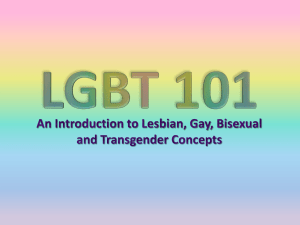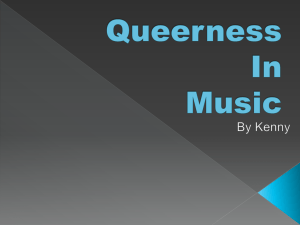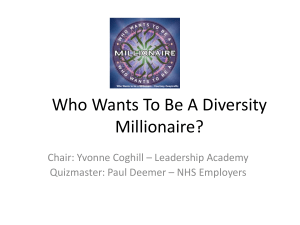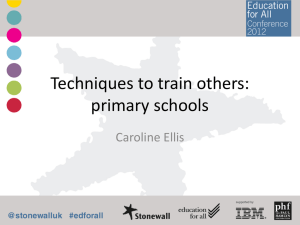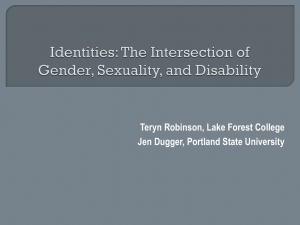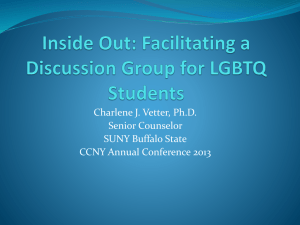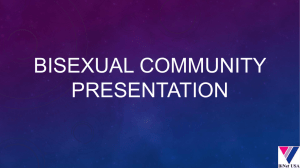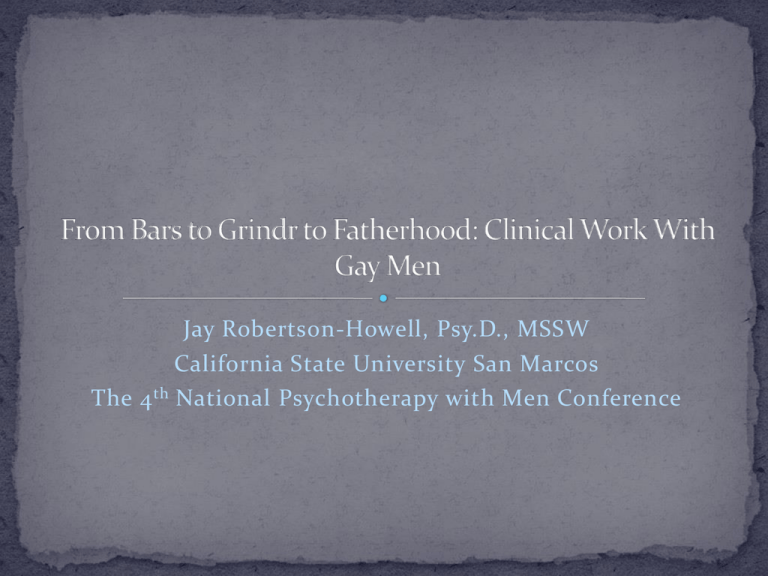
Jay Robertson-Howell, Psy.D., MSSW
California State University San Marcos
The 4 th National Psychotherapy with Men Conference
Identify three reasons that gay men might seek mental
health services
Identify three societal issues that impact the
psychological well-being of gay men
Identify the underlying emotion impacting the gay
male’s psychological functioning
Identify three strategies in developing an affirmative
therapeutic approach in our work with gay men
Health
Disparities
Mental Health
Disparities
Coming Out
HIV/AIDS
Clinical Issues
Substance Abuse
Relationship Issues
Gay and bisexual men showed higher prevalence of depression,
panic attacks and psychological distress than heterosexual men
(Cochran et al., 2003).
According to Remafedi et al. (1998), young gay and bisexual men
may be 7x more likely to attempt suicide than young
heterosexual men.
Although gay men are more likely than their heterosexual
counterparts to seek help for emotional distress, approximately
1/3 of gay men reported negative or mixed reactions from mental
health professionals (King et al., 2003).
Gay men exhibited lower self-esteem if they believed that
appearance, weight, and muscularity were important to
others (Fish, 2006).
Kaminski et al. found that gay men also believed that
increased muscularity would offer protection from physical
attack (2005).
Disclosure of one’s identity to others is usually associated
with better mental health (Morris et al., 2001), but other
factors need to be considered during the coming out
process.
Gay men, as well as anyone who has receptive anal sex, are at
higher risk for anal cancer due to an increased risk of becoming
infected with human papillomavirus (HPV) with gay and
bisexual men estimated to have 1 17x more likely chance to
develop anal cancer than heterosexual men(McRee, et al., 2010,
Tider et al., 2005).
“Some disparities, such as HIV and other sexually transmitted
infections, are associated with the sexual practices of men who
have sex with men (MSM)” (Wolitski, et al., 2008, p. 23).
Gay men may experience violence based on their sexual minority
status and/or within an intimate relationship (Herek, 2009 and
Houston, et. al., 2007).
Controversy related to the rate of alcohol use historically
reported to be 3x the general population
Bars as social gathering places, accessibility of alcohol, and
cultural norms of alcohol use
Alcohol use as a coping strategy for discrimination
Recent studies show that gay men use substances,
including alcohol and illicit drugs at a higher rate than the
general population – not just in large communities like NY,
San Francisco or Los Angeles (Ostrow and Stall, 2008)
Gay men and lesbians were more likely than heterosexuals
to have used recreational drugs (King, et al., 2003).
“Use of poppers appears to be a gay male phenomenon
(Fish, 2006).
DISCRIMINATION
HOMOPHOBIA
HETEROSEXISM
STIGMA
and a culture that idolizes MASCULINITY
Not to dismiss biological and genetic factors
The Holocaust and the
The Stonewall Riots
Mental Health Disorder until 1974
Reparative Therapy still promoted as a cure
Same-sex sexual activity criminalized in 14 states until 2003
– Lawrence v. Texas
Same-sex marriage and adoption by same-sex couples still
illegal in many jurisdictions
Being able to marry the person you love in all 50 states and
having that marriage recognized federally
Not having the need to “come out”
Knowing that I won’t be fired from my job based on my
sexuality
Having the security that my children will not be taking
away from me based on my sexuality
Having the freedom to talk about LGBT issues without
being accused of “forcing a homosexual agenda” on others
Not having economic, emotional, physical, or
psychological consequences if family and friends find out
about my sexuality
List based on Peggy McIntosh's article on white privilege
Premise that gay people in a heterosexist society are
subjected to chronic stress related to their
stigmatization (Meyer, 1995)
Minority stress can be experienced in the form of
ongoing hassles (such as hearing anti-gay jokes) and
more serious negative events (such as loss of
employment, housing, custody or children, and
physical and sexual assault) (DiPlacido, 1998)
“The everyday encounters of discrimination that
people of various marginalized groups experience
throughout their lives” (Sue et al. 2007)
“Brief and commonplace daily verbal, behavioral, or
environmental indignities, whether intentional or
unintentional, that communicate hostile, derogatory,
or negative slights and insults toward members of
oppressed groups” (Nadal, 2008, p. 23)
Living in a culture that worships masculine power
Being a gay man in a hyper masculine world
Being a gay man in a heterosexual society
Results in:
Living outside the BOX
SHAME
“To be gay in an uncompromisingly straight world is to
struggle to find love and, once found, to hold on to it.
We are men in a world where men are emotionally
disabled by our masculine cultural ideals (Downs,
2012, p. 62)
Overwhelmed by shame
Compensating for shame
Cultivating authenticity
Overwhelmed with being gay in a society that
promotes masculine power
Coping equals avoidance
Engaging in any behavior that works to lessen the
feeling of shame
Suicide
LGBT youth are 2-3 times more likely to attempt suicide
(Garofalo, et al., 1999)
Substance Abuse
Anonymous Sex
Grindr and other sites
Denying sexuality
Hyper sexuality with women
Getting married and starting families
Bisexuality
Anti-gay activities
“Best Little Boy in the World”
Ongoing search for validation
Stage 1 validation equals hiding sexuality
Stage 2 validation equals proving worth and deserving of
love
Hunger for validation and hypersensitivity to
invalidation
Inauthentic validation satiates briefly
Anonymous sex, promotions at work, body image and
muscularity
Rediscovering the essence of self and the deconstruction of
life built on shame
Decreased visibility in gay community
Movement towards distress in an effort to overcome
avoidant behavior
Reclaiming life that might be marked by ambiguity
Aligns with Cass’s synthesis stage
http://www.youtube.com/watch?v=R4PV4Vyluc8#t=1
0
Foreclosure v. acceptance
An unfulfilled life v. a fulfilled life
A conflict in values
Intersection between multiple identities
Sexuality
Masculinity
Race, ethnicity and national origin
Age
Ability
Socioeconomic status
Clark (2009) suggested that therapists help LGBT
clients establish a support system of other LGBT
individuals, help LGBT clients understand how
oppression has affected them, help desensitize the
shame and guilt associated with homosexual thoughts,
behaviors, and feelings, and allow for client’s
expression of anger at being oppressed.
Davies (1996 ) suggested that therapists amplify
Roger’s core provision of unconditional positive regard
in working with LGBT clients.
Internalized homophobia a target for therapeutic
intervention
Explores the effects of anti-homosexual prejudice on
the presenting complaint and therapeutic process
Foster the development of all aspects of an LGB client’s
identity and the enhancement of an LGB individual’s
experiences.
Work in assisting client to understand the different
emotional experiences he might be having and ways in
which he engages in avoidance strategies
Identify and work with values
Establish a plan of committed action that moves client
forward in living an authentic and fulfilling life
Older than average student presenting with depression
seen for 10 sessions over the course of a semester
Existential outlook which led to a negative selfconcept
Inability to solve life’s problems
Strong comparison to peers
“should be in a different place”
Search for validation in an effort to minimize the
effects of shame
Ongoing education related to LGBT issues
Developing competency
Knowledge, skills, and attitudes
A therapeutic space that reflects inclusiveness
Safe Zone
Pamphlets reflecting same-sex couples
Develop a therapeutic alliance that values diversity
Be familiar with APA Guidelines for Psychological
Practice with Lesbian, Gay & Bisexual Clients
Jay Robertson-Howell, Psy.D., MSSW
California State University San Marcos
Student Health and Counseling Services
jrobertson@csusm.edu
760-750-4974
Clark, D. (2009). Loving Someone Gay. Maple Shade, NJ: Lethe Press.
Cochran, S. D., Mays, V. M. and Sullivan, J. G. (2003). Prevalence of mental disorders, psychological
distress, and mental health services use among lesbian, gay, and bisexual adults in the United States.
Journal of Consulting and Clinical Psychology, 71, 1: 53-61.
Davies, D. (1996). Towards a model of gay affirmative therapy. In D. Davies & C. Neal (Eds.), Pink Therapy:
A Guide for Counselors and Therapists Working with Lesbian, Gay, and Bisexual Clients. Buckingham,
England: Open University Press.
Fish, J. ( 2006). Heterosexism in Health and Social Care. NY: Palgrave Macmillan.
Garofalo, R., Wolf, R.C., Wissow, L.S., et al. (1999). Sexual orientation and risk of suicide attempts among
a representative sample of youth. Archives of Pediatric and Adolescent Medicine, (153(5), 487-493.
Herek, G.M. (2009). Hate crimes and stigma-related experiences among sexual minority adults in the
United States: Prevalence estimates from a national probability sample. Journal of Interpersonal Violence,
24(1), 54–74.
Houston, E., & McKirman, D.J. (2007). Intimate partner abuse among gay and bisexual men: Risk
correlates and health outcomes. Journal of Urban Health, 84(5), 681–690.
Kaminski, P. L., Chapman, B. J., Haynes, S. D. And Own, L. (2005) Body image, eating behaviors and
attitudes toward exercise among gay and straight men. Eating Behaviors, 6, 3: 179-187.
King, M., McKeown, E., Warner, J., Ramsay, A., Johnson, K., Cort, C., Wright, L. et al. (2003). Mental health
and quality of life of gay men and lesbians in England and Wales: Controlled, cross-sectional study.
British Journal of Psychiatry, 183, 6: 552-558.
McRee, A. L., Reiter, P. L., Chantala, K., et al. (2010). Does framing human papillomavirus vaccine as
preventing cancer in men increase vaccine acceptability? Cancer Epidemiology Biomarkers and
Prevention, 19(9), 1937.
Morris, J., Waldo, C. R. and Rothblum, E. D. (2001). A model of predictors and outcomes of outness
among lesbian and bisexual women. American Journal of Orthopsychiatry, 71, 1: 61-71.
Morrow, SL. (2000). First do no harm: therapist issues in psychotherapy wit lesbian, gay, and bisexual
clients. In RM Perez, KA DeBord, & KJ Bieschke (Eds.), Handbook of Counseling and Psychotherapy with
Lesbian, Gay, and Bisexual Clients (pp. 137-156). Washington, DC: American Psychological Association.
Ostrow, D.G., & Stall, R. (2008). Alcohol, tobacco, and drug use among gay and bisexual men. In
Wolitski, R. J., Stall, R., & Valdiserri, R. O., (Ed.) Unequal opportunity: Health disparities affecting
gay and bisexual men in the United States. New York: Oxford University Press
Remafedi, G., French, S., Story, M., Resnick, M. D. and Blum, R. (1998). The relationship between suicide
risk and sexual orientation: Results of a population-based study. American Journal of Public Health, 88, 1:
57-60.
Tider, D.S., Parsons, J.T., & Bimbi, D.S. (2005). Knowledge of human papillomavirus and effects on sexual
behavior of gay/bisexual men: A brief report. International Journal of STD & AIDS, 16, 707–708.




